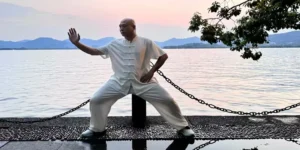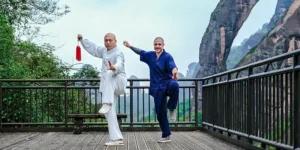The image of Tai Chi often evokes serene groups moving slowly in parks, a practice synonymous with stress reduction and improved balance. But beneath this peaceful surface lies a fighting art with combat application. So, how does Tai Chi as a fighting art actually work?

Tai Chi As Fighting Art Work
Tai Chi Chuan is a Chinese martial art for self-defense and combat effectiveness. Its power doesn’t rely on brute force but on a unique physical and mental principles:
- Jiè Lì Dǎ Lì (Borrowing Force to Apply Force): This is the basic. Tai Chi fighter learns to yield, redirect, and add their own energy to the incoming force, using the opponent’s force against them.
- Yǐ Róu Kè Gāng (Using Softness to Overcome Hardness): Tai Chi emphasizes relaxation and suppleness. By staying soft and responsive, the practitioner can absorb, neutralize, and counter hard, aggressive attacks with minimal effort. It’s like water effortlessly flowing around a rock.
- Tīng Jìn (Listening Energy): Developed through Tui Shou practice, this is the heightened sensitivity to perceive an opponent’s force, direction, intention, and connection to the ground through physical contact. This “listening” helps the Tai Chi practitioner to react instantaneously and appropriately.
- Zhěng Jìn (Whole-Body Power): Martial Tai Chi gets power from the ground up. Movements integrate the legs, waist, torso, and arms into a single coordinated action. This unified structure allows even a smaller practitioner to issue significant power efficiently.
- Zhān Nián Lián Suí (Stick, Adhere, Connect, Follow): Once practice is made, the Tai Chi fighter maintains a light but constant connection, adhering to the opponent’s movements. This allows them to feel changes instantly and follow those movements fluidly, without breaking contact or giving the opponent space to recover.
- Zhòngxīn Pòhuài (Disrupting Balance): Tai Chi combat is to break the opponent’s root and balance. The practitioner seeks to make the opponent unstable, making them vulnerable to throws, locks, or strikes.
Combat Tai Chi Techniques
Tai Chi Chuan, often called Tai Chi, is a centuries-old Chinese martial art. While modern taichi practice is often for wellness, its roots lie in self-defense and combat. This part explores tai chi styles, techniques, and forms while examining its different types of tai chi and their unique characteristics.

Understanding Tai Chi Chuan
Tai Chi Chuan combines philosophy, movement, and combat principles. Though often practiced for stress relief or flexibility, its tai chi chuan techniques focus on redirecting force, joint locks, and precise strikes. Key techniques include:
- Forms: Prearranged tai chi movements that train balance, coordination, and martial application.
- Push Hands: A two-person drill focusing on sensitivity, timing, and off-balancing opponents.
- Qin Na: Joint manipulation and grappling techniques incorporated into fighting styles.
Different Styles of Tai Chi
Over time, tai chi styles divided into distinct lineages, each emphasizing specific tai chi methods and combat strategies. Below are the most widely recognized types of tai chi:

Chen Style Tai Chi
- Features: Explosive movements, low stances, and a mix of slow and fast techniques.
- Combat Focus: Leverages spiral force (chan si jin) for throws and strikes.
- Key Forms: Lao Jia, Xin Jia.
Yang Style Tai Chi
- Features: Fluid, expansive movements with an upright posture.
- Combat Focus: Redirecting incoming force through softness and circularity.
- Key Forms: Yang 108-Movement Form, Simplified 24-Step.


Wu Style Tai Chi
- Features: Compact motions with a forward-leaning stance.
- Combat Focus: Accuracy in close-range strikesand joint locks.
Sun Style Tai Chi
- Features: Agile footwork blending Tai Chi, Xingyi, and Bagua.
- Combat Focus: Evasive maneuvers and rapid directional changes.
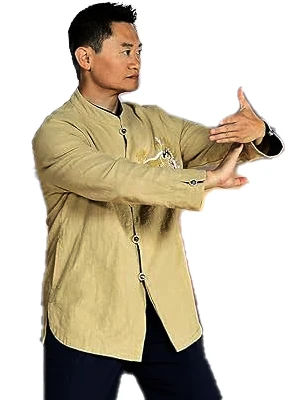

Hao Style Tai Chi
- Features: Simple movements with internal energy cultivation.
- Combat Focus: Subtle internal force application.
Tai Chi Techniques for Combat
Although there are many types of Tai Chi, they all share the same basic fighting principles.
- Peng (Ward Off): An expansive, supportive, upward-outward force used to receive, deflect, and neutralize incoming force while maintaining structure. It’s the basis for all other techniques.
- Lu (Roll Back): Yielding and transfering an opponent’s force, leading them off-balance. Involves circular movement, turning the waist, and absorbing/transferring energy.
- Ji (Press/Squeeze): Focused forward pressure, usually after a successful neutralization, using your body structure and coordination to overwhelm the opponent’s center.
- An (Push): A downward and forward pressing or sinking force, usually used to uproot ordisorganize an opponent, usually to the chest or shoulders.
- Cai (Pluck/Downward Pull): Grabbing and suddenly pulling or jerking the opponent downwards to break their posture and balance.
- Lieh (Split/Rend): Usinging reaction force from various directions to break or control the opponent’s joints.
- Zhou (Elbow Strike): Use the elbow to deliver a powerful short-range blow to the vital parts.
- Kao (Shoulder/Body Strike): Using the shoulder, hip, or entire body mass to bump, jolt, or uproot the opponent at close range.
- Qin Na (Seizing & Controlling): Use joint locks, acupressureand grappling techniques to control or subdue theopponent.
- Fa Jing (Explosive Power Emission): The sophisticated method of releasing stored elastic energy in a sudden, focused burst. This is a hallmark of Chen Tai Chi but present in all types of tai chi.
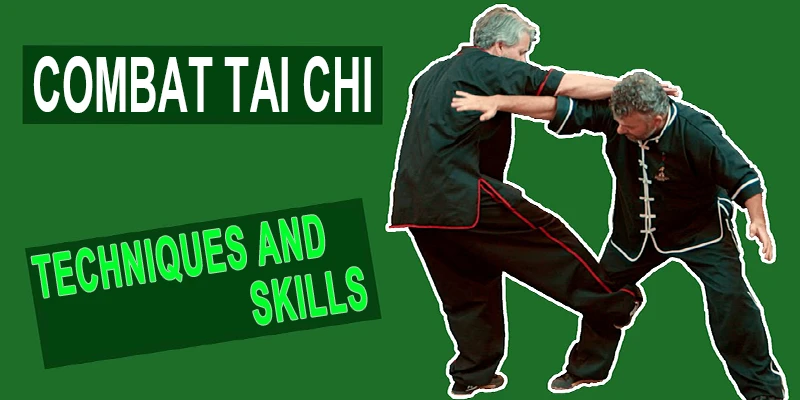
Training Tai Chi Combat Skills
Practicing tai chi for martial arts application requires specific training methods:
Solo form practice deepens understanding of postures, transitions, body mechanics, and energy flow.
San shou is systematically studying the specific combat techniques embedded within each movement of the form against a partner.
Traditional Tai Chi weapons (sword, broadsword, spear, pole) extend the body’s energy and principles, training coordination, power, and spatial awareness.
Sparring applies techniques, strategy, and sensitivity in a more free-form, responsive setting, bridging the gap between drills and real combat.
Tai Chi Martial Arts Training
Tai Chi Chuan is far more than gentle exercise; it is an effective internal martial art with a rich combat. This part outlines the core components and structure of martial training within Tai Chi, including how specialized tai chi programs.
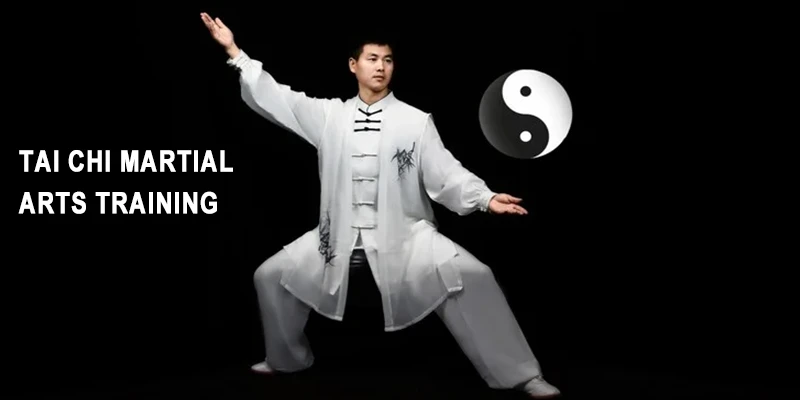
Martial Tai Chi Training
Tai chi martial arts training focuses on the original combat intent behind every movement. The key characteristics include:
You practice forms and movements with conscious awareness of the embedded locks, strikes, throws, and techniques. Tai chi focuses on generating power (Jin) from the ground, through relaxed body structure, coordinated by the waist, not through muscular tension. Also, it cultivates the ability to “listen” to an opponent’s force and intent, enabling skilled yielding, neutralizing, and countering.
Structured Tai Chi Classes
Classes Tai Chi: Basic martial skills are typically taught in group classes tai chi. These sessions introduce solo forms, basic qigong, introductory push hands patterns, and fundamental concepts.
Dedicated Tai Chi Program: Deep martial art often requires enrollment in a comprehensive tai chi program. Such programs move students systematically from basics to advanced partner work and weapons. They provide deeper instructor attention and a clear path for skill advancement of taichi class.
Medical Tai Chi vs. Martial Focus: A medical tai chi program focuses primarily on therapeutic goals. While based on Tai Chi principles, it typically downplays the intense partner work and combat training. Some schools may offer modified classes tai chi suitable for health-focused students.
Look for schools/instructors who:
- Explicitly teach the martial applications within the forms.
- Incorporate structured Push Hands training at various levels.
- Offer dedicated martial applications (San Shou) sessions.
- May include weapons training in their training.
- Discuss Tai Chi’s principles and theory in the context of combat strategy.
- Clearly differentiate their tai chi program focus (martial, health/medical, or both).

